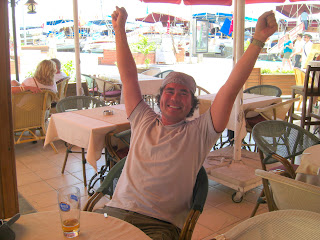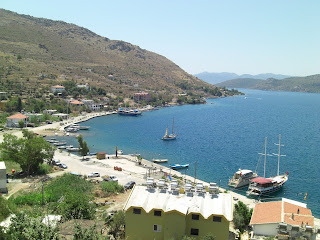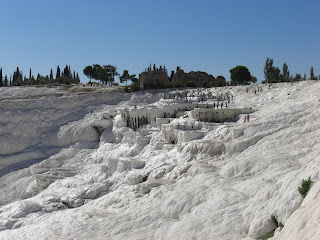Ruins, beaches and sleeping in treehouses - Olympos is a great place to take a break.
After an exceptional time in Pamukkale, we were all set to get a quick glimpse of what Lonely Planet (LP) means when it says "over-developed package tourist hellhole" - which apparently describes an unfortunate majority of the towns along Turkey's Mediterranean coast.
We had heard nothing good about Marmaris, however there were two things that helped us make the decision to go there. Marmaris is the closest town to the Hisarnou Peninsula, and LP describes a fantastic day that can be had, along deserted coastlines, scooting around the 120kms or so of coastline (I was very eager to put my newly acquired motorcycle licence to practical use!).
The other reason was that there was the first Wallabies Tri-nations match being played that Saturday. Being in a big enough touristy town would help ensure that at least one pub there had access to Sky Sports so we could watch the big game.
We arrived late morning, quickly checked into our expensive, shoebox of a room (easily the smallest we've had so far), and searched out a pub showing the rugby. A couple of false leads and much walking of the marina led us to a restaurant/pub that was more than willing to show the game (in exchange for our patronage)!
Full time! A great game, Wallabies 16, Springboks 9.
It was great to see a Wallabies victory after a long drought of not watching any rugby at all since we had left!Afterwards, we cruised around the strip and the marina in Marmaris - there wasn't a lot to look at, however I'm happy to report that it was no where near as bad as Sharm el Sheikh and Naama Bay, in Egypt!
We found ourselves a scooter that night and the next day headed out to the Hisaronou Peninsula. The coastline was absolutely beautiful, and it was great to get a glimpse of what the coastline of Turkey used to look like, before all of the over-development!
We stopped in the village of Bayir for morning tea and sat for about half an hour as the owner of a honey shop chatted to us about his love of sailing on the Med - we were eagerly looking forward to our week on the Med as well!

A lot of honey!
One of the features of the village are the amazingly old trees - known as Plane or Selvi trees. The one in the center of town is reputed to be more than 2000 years old - by walking around the tree it is meant to give you a long and happy life. We both took a turn!

The Sacred Tree - bringing long life and good luck if you walk around it
We moved on to one of the coastside villages for a spot of lunch and a bit of a swim. It was fantastic to escape the crowds for a while and just relax in the clear blue waters of the Med.
From there, we kept going around the peninsula, taking in the landscape and the view. We spied a little bay where there were a lot of locals swimming so we stopped and dove right in - we didn't notice the sign that said "5 lira per person" - oops! We sheepishly handed over the cash to the local patriarch, before heading on our way.
We ended the day, driving on fumes as we headed back to Marmaris - we definitely got the full value out of our trusty scooter and had a brilliant day!
Steph putting on yet more sunscreen - vital equipment for scooting!
We stopped for dinner at a "proper" Chinese restaurant (they even hired genuine Chinese people to usher people in the door) and then packed our bags and caught the bus overnight to Antalya (about 14 hours), where we then caught a minibus (another 1.5 hours) to Olympos, our next destination.We arrived early in the morning, a little groggy after sleeping lightly on the overnight bus to Antalya. We had brekkie and then retired to our air-conditioned room for a bit of a clean up and to settle in. We had a bit of nap and then got up, had some lunch and headed to the beach.
The interesting thing about the beach is that it is necessary to walk through the ruins of Olympos in order to get there from the village. As such, every day you're required to pay the entrance fee to the Olympos ruins - absolute genius on the part of the Turkish foundation looking after the place!
We spent the afternoon on the beach - a pebble beach, however the water was amazingly cool, clear and refreshing; the perfect antidote to the amazingly hot weather we had in Olympos!
That night we met up with a couple from the UK that we would end up spending quite a bit of time with both here as well as in Goreme, Tamsie and Minesh. They were great fun and good company to help while away our relaxing time in Olympos.
Our second day at Olympos, we booked in for a sea kayaking trip, just around the shoreline of the bay. It was a great way to see some more of the amazing coastline, as well as get out and swim amongst some of the small caves in the cliff faces. Fantastic to get away from the crowds on the beaches as well!

Me and the sea kayaks - dragging them down the stream to the beach was well worth the peace of the day that we had, paddling up the coastline.
We ended up spending 4 days in Olympos, and the theme was roughly the same - get up late, have brekkie, wander to the beach. Have a swim, wander back for lunch, then either spend the afternoon in a hammock, reading a book or head out to the beach again. Bliss!
On our last night we visited Chimaera - the mountain of the eternal flame! The original legends said that there was a creature - called a chimaera - living under the mountain and the flames were a result of the creature breathing while it slept.
We caught a minibus after dinner and hiked up the hill in the dark - this took about 30 minutes or so. By doing the hike at night, we got to see the flames to full effect. It was still amazingly hot, though, and we were all drenched in sweat by the time we reached the top.


Unfortunately we didn't have any marshmallows to roast on the flames, so we had to settle for just watching the little fires as the burned at random spots all over the hill. A couple of Germans near us succeeded in blowing out one of the smaller flames, and spent the next few minutes frantically trying to re-light the flames with sticks and leaves. Very funny to watch.

Me, Steph, Minesh and Tamsie - trying to cool off next to naked flames is not the best idea in the world!

Me, Steph, Minesh and Tamsie - trying to cool off next to naked flames is not the best idea in the world!
The only other thing that punctuated our stay in Olympos is the stomach bug that flew around the entire camp and several people, including myself, spent 24-48 hours vomiting and "going at both ends" which was fantastic. Amazingly, the only person that seemed not to be affected was Steph - the super bug she suffered in Jordan must have hardened her system!
After our four days were up, we said farewell to Olympos and were ready to embark on our trip to Cappodocia. We had arranged to catch up with Minesh and Tamsie in the town of Goreme as they were also heading there for their last stop in Turkey before returning to the UK.
Our trip started with the the overnight bus to Ankara to get our Indian visas drawn up in our passports. Luckily, this time our applications were accepted without incident, which was fantastic as our timing was getting a little short - the Indian embassy only accepts applications between 10:00 and 11:00am, Mon-Fri and, as it was Friday, it was literally our last chance.
We then eagerly got on the next bus to Goreme that afternoon, only about 4-5 hours to arrive in the evening and the next stage of our Turkish travels!
After our four days were up, we said farewell to Olympos and were ready to embark on our trip to Cappodocia. We had arranged to catch up with Minesh and Tamsie in the town of Goreme as they were also heading there for their last stop in Turkey before returning to the UK.
Our trip started with the the overnight bus to Ankara to get our Indian visas drawn up in our passports. Luckily, this time our applications were accepted without incident, which was fantastic as our timing was getting a little short - the Indian embassy only accepts applications between 10:00 and 11:00am, Mon-Fri and, as it was Friday, it was literally our last chance.
We then eagerly got on the next bus to Goreme that afternoon, only about 4-5 hours to arrive in the evening and the next stage of our Turkish travels!














































































